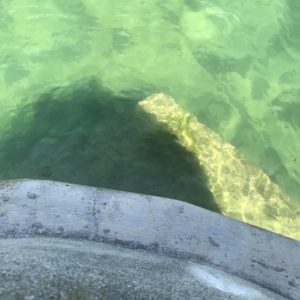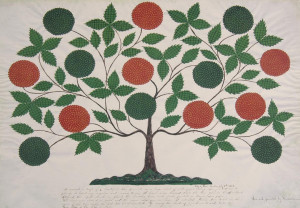This month’s Convivio Book of Days calendar focused on print and letterpress, and now we come to the days that mark the reason why: It is Bartlemas on the 24th of August (St. Bartholomew’s Day) and on the 28th, it’s St. Augustine’s Day. Printers and brewers both find a patron saint in St. Augustine, but it is St. Bartholomew that brings the most bookish of celebrations, for it is Bartlemas Day that brings the traditional printers’ Wayzgoose… and tonight, here comes ours: Read on for your own invitation to the virtual Library Wayzgoose Festival that I am hosting for Florida Atlantic University Libraries’ Jaffe Center for Book Arts this very evening.
Bartlemas celebrates St. Bartholomew, who is a patron saint of bookbinders… but still, his day is just as important to the other two branches of the book artist’s craft: papermaking and printing––the one sometimes called the Black Art. The Wayzgoose tradition itself comes out of the shifting of the seasons and the recognition that summer, at least here in the Northern Hemisphere, is waning.
Not much is known about St. Bartholomew himself. He was one of the Twelve Disciples. He is thought to have traveled to India, but tradition says that he met his end in Armenia in the first century. His martyrdom was a gruesome one––one that by association made St. Bartholomew a patron saint of butchers (a common trade amongst my paternal ancestors) and of tanners and of bookbinders, who very often bind books in leather. I’ll leave the method of his martyrdom, based on those associations, to your imagination, but early bookbinders found it a worthy connexion, hence his patronage of their craft.
For papermakers, the connexion goes back to the days before glazed glass windows. Back then, it was waxed paper that was used to keep out the elements, and the arrival of Bartlemas was the signal that it was time to paper the windows in preparation for winter. Once this St. Bart’s window paper was made, the papermakers went back to making paper for the printers, clearing out the vats and recharging them with new pulp made from rags that had been retting all summer long.
But it is the printers who really know how to celebrate St. Bartholomew’s Day. Bartlemas, being a full eight weeks past the summer solstice, brings with it each year a certain reality: Sunlight, like summer, is waning, and the days are growing darker and darker. Along with the papering of the windows at Bartlemas came the necessity of illuminating the print shop with lanterns and candles. A good print shop proprietor would make a celebration of the day. Randall Holme, in 1688, gave us this description of the Bartlemas Wayzgoose: “It is customary for all journeymen to make every year, new paper windows about Bartholomew-tide, at which time the master printer makes them a feast called a Wayzgoose, to which is invited the corrector, founder, smith, ink-maker, &c. who all open their purses and give to the workmen to spend in the tavern or ale-house after the feast. From which time they begin to work by candle light.”
To be sure, there was a good quantity of ale consumed as part of the Wayzgoose. In some places, mead, the delightful intoxicating beverage made from honey, was the beverage of choice. Especially in Cornwall, where a Blessing of the Mead ceremony takes place even today at this time of year. Continuing the road of connexions, our friend St. Bartholomew is also a patron saint of beekeepers, and as we gather our stores for the coming winter, it is traditional, too, to bring in the honey crop on his feast day.
Finally, here’s another bit of Bartlemas Wayzgoose lore that I love: It was on August 27, 2010, that the Jerusalem Post reported that Johannes Gutenberg’s 42-Line Bible, the first book printed from moveable type, was completed on St. Bartholomew’s Day in 1454. Some claim, too, that that first printed book explains why printing has a history of being called the Black Art. They say that Johannes Fust, Gutenberg’s business partner, sold several of the printed bibles in France without explaining how they were made. When it was discovered that the books were identical copies of each other, Fust was accused of witchcraft and was briefly imprisoned for that crime. It was a different world back then, with information spread by rumors. It was the printing press, though, that ushered in an age of knowledge and literacy and enlightenment. Some would say, too, that we have reverted back to those medieval ways: there are those who claim time and time again that the printed word is not to be trusted, calling trusted information sources “fake news,” feeding us their own brand of misinformation through social media, which, when you get right down to it, is just the 21st century equivalent of medieval rumor. Here we are, 566 years after Gutenberg’s first books were printed, and we find ourselves again no wiser than Johannes Fust’s accusers.
One thing is certain: if you are a book artist or if you are a book enthusiast, St. Bartholomew’s Day is a very auspicious day for you. For this Bartlemas Wayzgoose, then, certainly we have cause to celebrate books and the people who make them: the papermakers, the printers, the bookbinders, the book artists. This Bartlemas, let us raise our glasses to St. Bart and to all of these good artisans… and to celebrate the printed word and make a pledge to value its importance to good living and to good citizenship. The Black Art may just be more important than we realized.
Perhaps you can join us tonight? I’d love it if you did. Here’s the official trailer (properly a good bit o’fun) that we created for tonight’s premiere:
I am, by default (I can’t imagine anyone else would’ve done it), your host for this virtual 2020 Library Wayzgoose Festival. The official premiere is at 7:00 PM Eastern Daylight Time, from wherever you are in the world, at the Vimeo Channel of the Jaffe Center for Book Arts. And you may view the Wayzgoose video anytime after that, as well. I’ll be interviewing the delightful Catalina Rojas, the proprietor of Puropapel, a letterpress and design studio in Miami. We’ll have music by the Lubben Brothers, a West Palm Beach folk band of incredibly talented triplet brothers (and someday you’ll see them on a national televised broadcast of the Grammies and say, “Didn’t we see these guys on that Wayzgoose thing?”). And I’ve got some other fun surprises in store for you, too.
L O N G L I V E P R I N T !


